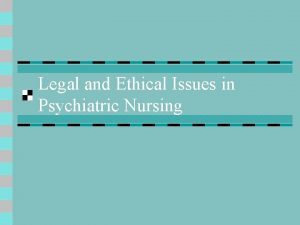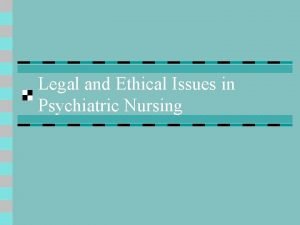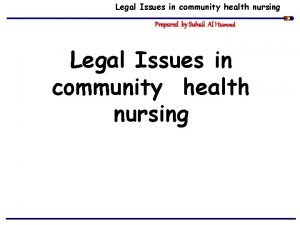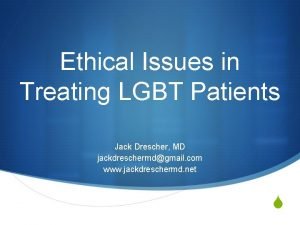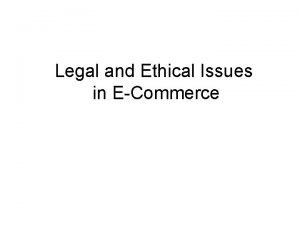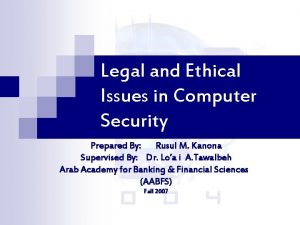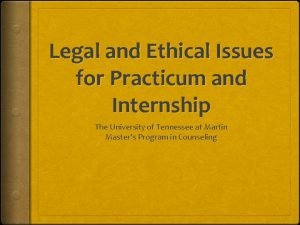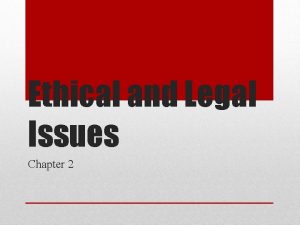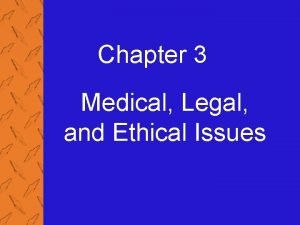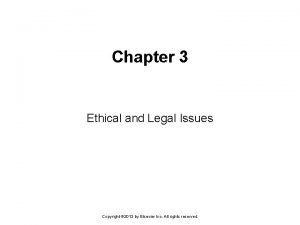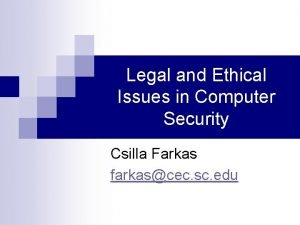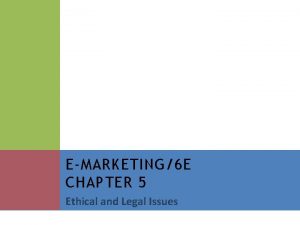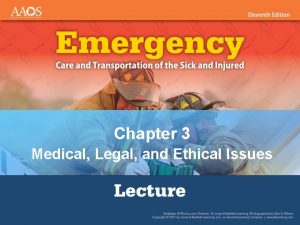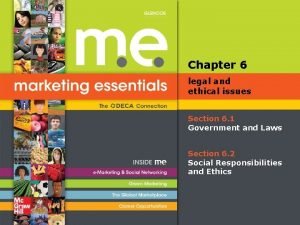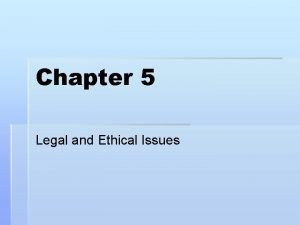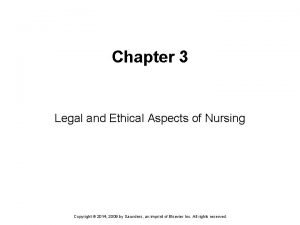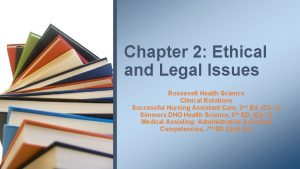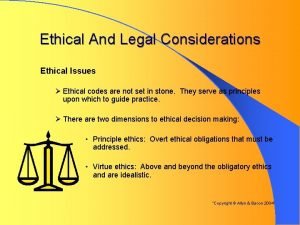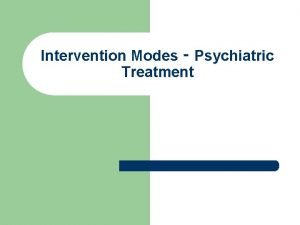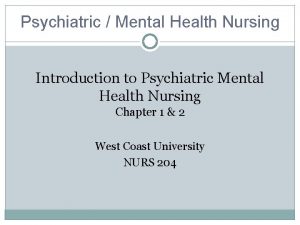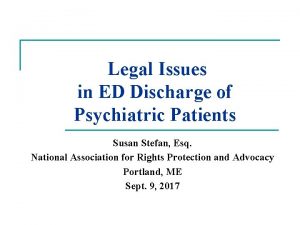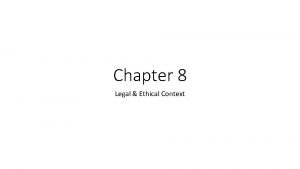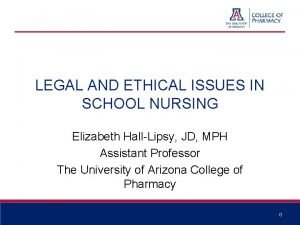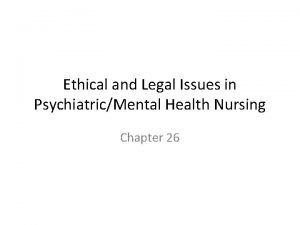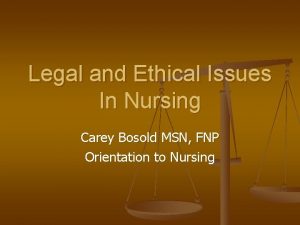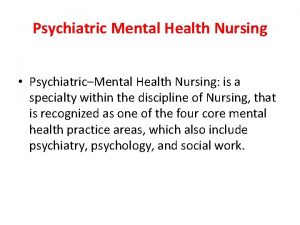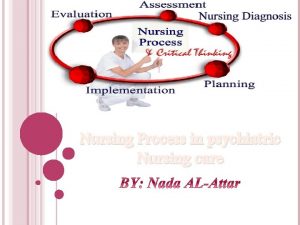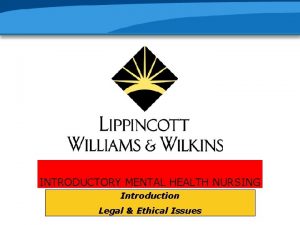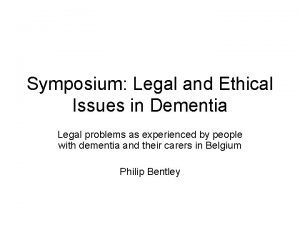Legal and Ethical Issues in Psychiatric Nursing Patients






















- Slides: 22

Legal and Ethical Issues in Psychiatric Nursing

Patient’s Bill of Rights Civil Rights n Client Consent n Communication n Freedom from Harm n Dignity and Respect n Confidentiality n Participation in Their Treatment Plan n

Admission to the Hospital Voluntary n Involuntary n

Client’s Rights Under the Law Right to Treatment n Right to Refuse Treatment n Right to Informed Consent n Rights Regarding Restraint and Seclusion n

Right to Treatment Clients have the right to receive treatment for psychiatric problems n Rx must meet the following criteria: n The environment must be humane n Staff must be qualified and sufficient to provide adequate Rx n The plan of care must be individualized n

Right to Refuse Treatment n n When forcible medication is used to prevent violence to third parties, to prevent suicide, or to preserve security, the court noted that the med is being used as a chemical restraint—changes from individual rx to public protection If it is deemed that an individual is unable to make a competent, informed, and voluntary decision re: rx, courts have stated that the med determinations and rx plans are best left to the professionals

Rights Regarding Seclusion and Restraint n Legally, behavioral restraint and seclusion are authorized as an intervention when: n n n The particular behavior is physically harmful to the client or a 3 rd party The disruptive behavior presents a danger to the facility Alternative or less restrictive measures are insufficient in protecting the client and others from harm When a decrease in sensory over stimulation (seclusion only) is needed When a client requests seclusion

Rights Regarding Seclusion and Restraint (cont) n n The use of seclusion and restraint is permitted only: On the written order of a physician n n n Must be face-to-face exam by MD within 1 hr of the application Next 4 hrs can have phone order Next 4 hrs need to have face-to-face exam…etc Clients should be assessed q 15 min Restraints must be rotated q 2 h Food and fluids should be offered at least q 2 h

Rights Regarding Seclusion and Restraint (cont) n Documentation— Should reflect that lesser restrictive methods were tried n The behavior leading to restraint/seclusion n

Tort Law n n n Torts are civil wrongs for which money damages are collected by the injured party (plaintiff) from the wrongdoer (defendant) Civil liability for nsg practice falls in the area of tort law 3 types of torts: n n n Intentional Quasi-intentional Unintentional

Intentional n Assault n n Battery n n An act resulting in a person’s apprehension of an immediate harmful or offensive touching (battery) Harmful or offensive touching False imprisonment n n An act with intent to confine a person to a specific area The use of seclusion or restraint that is not defensible as being necessary or in the pt’s best interest

Quasi-Intentional n Defamation is made up of 2 torts: Slander or oral communication n Libel or written communication n n Breach of confidentiality

Unintentional n Professional negligence n n Involves harm resulting from the failure of a person to conduct himself or herself in a reasonable and prudent manner 4 items needed to prove negligence are: n n Duty—measured by standard of care Breach of duty—conduct that exposes the client to an unreasonable risk of harm Proximate cause—Intervening actions or persons that were, in fact, the causes of harm to the client Damages—pain and suffering

Duty to Warn Third Parties Tarasoff case of 1976 n A duty to warn third parties exists when a therapist determines that the pt presents a serious physical danger to another person n

Defense Mechanisms

Repression: the active unconscious process of keeping out or ejecting from the consciousness ideas or impulses that are unacceptable to the person n Denial: refusal to perceive or face reality as it actually exists n Acting out: the use of actions versus reflection or true experiencing of feelings to deal with stress or conflict n Rationalization: use of a contrived, socially acceptable and logical explanation to justify unpleasant material and to keep it out of consciousness n

n n n Projection: attributing one’s own unacceptable motives or characteristics to another person or group Displacement: the discharge of pent-up feelings onto something or someone else in the environment that is less threatening than the original source of the feelings Reaction formation: prevention of awareness or expression of unacceptable desires by adoption of opposite behaviors in an exaggerated way

Intellectualization: the overuse of abstract thinking or generalizations to control or minimize painful feelings n Undoing: atonement for or attempt to dissipate unacceptable acts or wishes n Compensation: counterbalance for deficiencies in one area by excelling in another area n Identification: incorporation of the image of an emulated person, then acting, thinking, and feeling like that person n

n n n Introjection: treating something outside the self as if it actually exists inside the self Regression: returning to an earlier level of adaptation Sublimation: modification of an instinctual but socially unacceptable impulse into a constructive acceptable behavior Suppression: the conscious inhibition of an impulse, idea, or affect; the person has full awareness of the behavior Humor: emphasis on ironic or amusing components of a crisis, conflict, or stressor

n n Splitting: compartmentalization of opposite-affect states and failure to to integrate positive and negative aspects of self or others, resulting in polarized images of self and others as all good or all bad Self-Observation: reflection on one’s own behavior, thoughts, or feelings, followed by appropriate response Self-assertion: expression of thoughts and feelings in direct ways that are not manipulative or intimidating Altruism: devotion of self to serving others as a way to mange conflict and stress

n n Affiliation: turning to others for support and help when stressed or conflicted, without attempting to make others responsible for taking care of the person Anticipation: anticipating consequences of events yet to come thinking of options, solutions, and alternatives Help-Rejecting Complainer: repeated requests for help, suggestions, or advice that is then rejected Passive Aggression: expression of aggression toward others in indirect or nonassertive ways; covert hostility and resentment masked by over-compliance

Omnipotence: feeling or acting superior to others or as if one has special abilities or powers n Isolation of Affect: separation of feelings from thoughts and ideas that are originally associated with them n Fantasy: gratification of frustrated desires, achievements, and relationships by substituting them with daydreams and imagery n
 Legal issues in psychiatric nursing
Legal issues in psychiatric nursing Ethical issues in psychiatric nursing
Ethical issues in psychiatric nursing Ethical and legal issues affecting the nursing assistant
Ethical and legal issues affecting the nursing assistant Legal issues in community health nursing
Legal issues in community health nursing Ethical issues in treating lgbt patients
Ethical issues in treating lgbt patients Introduction of nursing process
Introduction of nursing process Nursing process in psychiatric nursing
Nursing process in psychiatric nursing Ethical media issues
Ethical media issues Law and ethics in information security
Law and ethics in information security Legal and ethical issues in use of ict
Legal and ethical issues in use of ict Ecommerce legal issues
Ecommerce legal issues Legal and ethical issues in computer security
Legal and ethical issues in computer security Professional and ethical issues during internship
Professional and ethical issues during internship Chapter 2 ethical and legal issues
Chapter 2 ethical and legal issues Medical legal and ethical issues chapter 3
Medical legal and ethical issues chapter 3 Chapter 3 legal and ethical issues
Chapter 3 legal and ethical issues Ethical issues in computer security
Ethical issues in computer security Legal and ethical issues chapter 5
Legal and ethical issues chapter 5 Legal and ethical issues chapter 3
Legal and ethical issues chapter 3 Chapter 6 legal and ethical issues
Chapter 6 legal and ethical issues Chapter 5 legal and ethical issues
Chapter 5 legal and ethical issues Legal and ethical aspects of nursing
Legal and ethical aspects of nursing Ethical and legal issues chapter 2
Ethical and legal issues chapter 2
